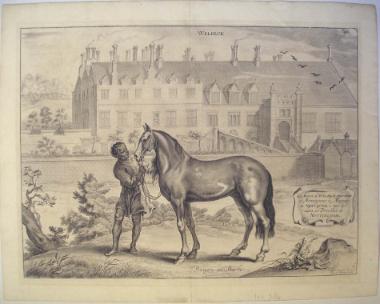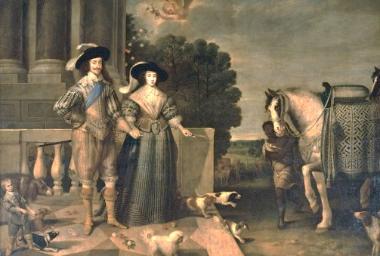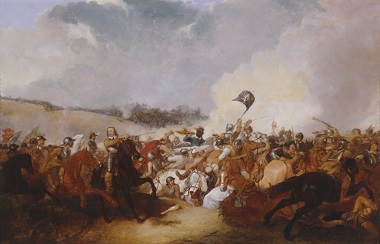Africans in the British Civil Wars, 1642 - 1651
4 May 2021
Written by Sophie Merrix, ESRC PhD Candidate at Lancaster University and Early Modern History Editor of Epoch Magazine, this article looks at racial diversity on the battlefields of the Briitish Civil Wars.
1642- England was at war. Cavalier vs Roundhead, Englishman vs Englishman, and African vs African? Scholarship by Imtiaz Habib, Miranda Kaufmann and Onyeka Nubia, while disagreeing on the status of Africans in England, has irrefutably demonstrated that they were present in the Tudor Period.[1] But what part did Africans play in the Civil War? On which side did they fight? Archival records, baptisms, burial accounts and the diaries and letters of prominent military actors hold partial answers to these questions. How far we are able to see the autonomous actions of Africans in this period remains questionable but, these sources show it would not have been unusual to witness racial diversity on the battlefields of the British Civil Wars.
Collecting archival information about Africans in England is difficult as evidence is fragmentary and partial even at the best of times. Assembling a case for the existence of Africans in Civil War Britain is much harder, as conflict either severely impacted or meant the cessation of many standard record keeping practices for a number of years. Some of the Africans uncovered and showcased in this article have been found by searching archives and primary sources using a number of ethnic descriptors known in this period to refer to someone of African ethnicity. These terms include: ‘blackamoor’, ‘negro’ and ‘moor’ alongside their spelling variants. Current collected records covering the Stuart period, 1603-1714, include 61 references to Africans between the years 1630 and 1660.[2] This article will however focus on the written records and accounts from the Civil War era. It will also highlight a number of illustrations and paintings that allude to the places and positions assumed by Africans in this period.
What started an investigation into the roles of Africans in the British Civil Wars is the existence of a baptism record from 30 March 1645 of John Americanus, a 'blackamore', in Newark.[3] Baptisms are typically seen as events that occur shortly after birth in early modern England, but a large number of Africans were baptised as adults after arriving in England and converting to Christianity. Americanus’ record does not include his age, nor does it list the names of his parents. From this we can deduce that he was an adult convert. Newark was a fiercely contested hotspot during the Civil War, besieged by Parliamentarians and defended by Royalists on a number of occasions. Three sieges occurred here in consecutive years from 1643 to 1646, overlapping with the year of John Americanus’ baptism. There are no other records that explicitly reference Americanus and therefore no further information about whether he fought in the Civil War and, if he did, which side he fought for or his experience. In fact, Imtiaz Habib has concluded this individual was “almost certainly an American Indian” therefore perhaps he is irrelevant to a study of Africans in the Civil War.
Although Americanus’ ethnicity is under question, a handful of other accounts refer to 'blackamores' in Newark at this time. A snippet of events from one of the Newark sieges is recorded in The Diary of Abraham de la Pryme, the Yorkshire Antiquary which recalls a Scottish soldier taken prisoner by ‘a blackamore’:
‘A blackamore took a Scottish soldier prisoner upon which the poor Scot, being almost frightened out of his wits, pray’d heartily, saying “O God! O God! O God! have mercy upon me saul, de deel’s got my body, de deel’s got my body;” and the fellow was so frightened he would not follow the black, so that he was forc’d to kill him’.[4]
Again, the account is partial, but it confirms there were identifiable 'blackamores' or Africans at Newark and fighting in the British Civil Wars. This source contains no information as to what side the 'blackamore' was on but the identity of his prisoner as ‘Scottish’ suggests that he was a Royalist. This account was written in reference to the siege of March 1645 to May 1646 which led to the town’s surrender at which point the Scottish had joined the Parliamentarian cause. According to Jennings, the African mentioned by Abraham de la Pryme was either a servant of the Earl of Newcastle or of another Royalist.
The Earl of Newcastle, William Cavendish, was known to have black servants at Welbeck (25 miles from Newark) before the Civil War.[5] More specifically, there is evidence that Cavendish employed Africans as grooms for his horses. African grooms associated with Cavendish appear in illustration on engraved plates for his 1658 treatise on horsemanship, The New Method and Extraordinary Invention of Riding Horses (Figure 1).

Figure 1: An African Groom, La Méthode Nouvelle et Invention Extraordinaire de Dresser les Chevaux (1658). Welbeck, Nottinghamshire.
There is also a list of payments made to the grooms of Cavendish’s household in 1661:
‘To Jon Lamming ye groom… £2
To Richards ye Groome of ye Padnage £3 10s
To Wm Goldin ye groome of ye great stable’ £3
To Edward Mauds ye other groome here £4’[6]
However, whether any of these individuals are of African origin is unknown as their ethnicities are not noted. As the African groom depicted in Figure 1 is not named it is impossible to link him to the above payroll record but it is possible that he was one of those paid in 1661, just three years after the engraving was made.
It would not have been unusual for William Cavendish to employ and pay black groomsmen. Histories of Africans in early modern England reveal that they worked in a number of roles from musician, cook, and laundress, to sailors, and servants.[7] Evidence where Africans were paid for their labour exists for John Blanke, a trumpeter in the court of Henry VII and VIII, who received 20 shillings for a month’s work in December 1507.[8] A more contemporaneous example is of James the 'blackamoor', a cook, who received regular payments (£5, 4 shillings in March 1640) from the Earl of Bath. Evidence demonstrates that Africans were in diverse and paid employment in early modern England at the time of the civil war.
The following painting of Charles I and Henrietta Maria (Figure 2) depicts an instance of an African leading a horse to the King and Queen in the 1630s thus suggesting that the practice of employing African groomsmen had existed for a number of decades. The evidence from Cavendish, 1658, suggests that this remained the case coming out of the Civil War years.

Figure 2: Daniel Mytens: ‘Charles I and Henrietta Maria Departing for the chase’, c.1630-2, oil on canvas, 282 x 377.3 cm, Royal Collection, RCIN 404771.
Despite this helpful contextualisation for Figure 1, it is unlikely that the ‘blackamore’ mentioned by Abraham de la Pryme was a groomsman. The described events of 1645-46 suggest that he was a soldier and a parish record from Leeds confirms that Africans were indeed employed as such during the Civil Wars. This particular parish account is also linked to the Earl of Newcastle and is of ‘William, a Blackamore, a soldier under the Earle of Newcastle’, buried 16 July 1643.[9] It is likely that William accompanied the Earl of Newcastle into battle and died at the encounter of Adwalton Moor (June 1643) on the outskirts of Leeds. William’s death in 1643 means that he could not have been the 'blackamore' at Newark in 1645, nor could he have been the African groom tending to the horse at Welbeck. Evidence therefore suggests that either the Earl of Newcastle employed multiple Black soldiers or that as Jennings also suggests, the ‘blackamore’ mentioned by de la Pryme was associated with a different Royalist officer.
Other examples of Africans with Royalists in the Civil War years can be seen in Figures 3 and 4. Both Prince Rupert of the Rhine and Lord Byron can be seen posing with African boys in an ornamental manner in these paintings. Africans were increasingly used in the late seventeenth century as accessories in paintings to draw attention to the wealth of the white subject.[10] The use of Africans as accessories in this period makes sense when studying the painting of Rupert. The young African is extravagantly dressed and shown in a position of servitude, quite literally, under Rupert’s hand. Without written evidence that documents Africans on the battlefields as ‘soldiers’ it would be easy to dismiss these paintings as simply fitting with the ornamental trend of the period, to assume that Africans were for decoration and nothing more. The case of 'William, a Blackamore', and the unknown 'blackamore' at Newark allow us to question this as does the fact that both Rupert and John had established African connections. Perhaps these two prominent Royalists also employed African soldiers in a similar way to William Cavendish? Fragmented documentary evidence makes this hard to ascertain.

Figure 3: Prince Rupert of the Rhine, 1653-4
In the painting of Lord Byron, the positioning of the African tending to the horse suggests that he, like many other African boys and men, was a groomsman. Again, his regal attire points to what was becoming an established tradition in England at this time. Tracing the Civil War activities of Lord John Byron and Prince Rupert of the Rhine highlights the Battle of Marston Moor in July 1644 as a point when the two marched together and fought alongside the Earl of Newcastle, with Rupert also being present with Cavendish at Newark, 1645. On these occasions there may have been multiple African soldiers fighting for the Royalist cause. With Rupert present at Newark and having a credible African connection perhaps it was an individual fighting for him that we have documentary evidence of.

Figure 4: Lord John Byron, c.1643, by William Dobson.
African figures are not just seen in association with Royalists. In fact, there are a similar number of instances and images of Africans with Parliamentarians. The following reference, to a Parliamentarian Captain in A Treatise Touching the Breeding of Horses, Lord Thomas Fairfax, was found by Andy Hopper and made available by Sarah Clarke at the National Civil War Centre:
“At Newkirk (near Wakefield Segar)…some Mares fell to the Shares of some of my Sold[i]ers which by Reason of their driving did chance to foal the same Night that they were brought to the Camp at which Time one Captain Antonis a Moor did lay in my Quarter who told me that every Foal had in his Mouth above her Tongue and proportioned like the same Bag or Bladder, which did contain a Liquid Substance like a Gall, that as soon as the Colt did attempt to suck he did swallow the same which (say’d he) we in Barbary be careful to pull away after affirming that those Horses from whom those be taken shall live longer and be more free from many Diseases than the other…”
This extract, from Lord Fairfax’s papers, possibly references the 1643 Parliamentary attack on Wakefield. The important figure in this text is ‘Captain Antonis a Moor’, with ‘Moor’ likely being his ethnic descriptor, as it was for many other Africans in this period.[11] For Antonis to be a captain in this period, when English colonies in the Americas were developing a racial ideology that would soon underpin the labours of millions of Africans, is surprising. It is also strongly indicative of the existence of innate juxtapositions between racial treatment in England and in the Americas. This juxtaposition is present throughout the Stuart period. Little else is known about Antonis which makes his ethnicity and position hard to confirm but he is mentioned in the papers of Fairfax as a trusted and knowledgeable individual. In this account we again see an association between Africans and horses. Here, Captain Antonis is giving advice as to how foals ought to be handled using a practice carried out by ‘we in Barbary’ to ensure good health. This information alludes to Antonis’ heritage, as a Moroccan and therefore speaks to his African ethnicity. Evidence supports and adds to Hodkinson’s conclusion to demonstrate that in all probability black soldiers encountered on both sides in the British Civil Wars were neither pirates nor enslaved Africans, but free men.[12]

Figure 5: Cromwell, c.1655-8, by Thomas Wyck http://www.historicalportraits.com/Gallery.asp?Page=Item&ItemID=353&Desc=Oliver-Cromwell-%7C-Thomas-Wyck
Oliver Cromwell, Lord Protector of the Commonwealth of England, Scotland and Ireland 1653-8, was a leading general on the Parliamentary side in the British Civil Wars. He too is depicted in paint in association with Africans, most distinctively in the work of Thomas Wyck (1655-8). This portrait includes a black servant preparing to hand Cromwell his helmet, demonstrating Cromwell’s connections to Africans and Africa in this period. Unfortunately, the painting does not reference a Civil War battle but English military action in the Mediterranean after the wars in 1655; therefore, it cannot be used to suggest that Africans specifically fought alongside Cromwell in the Civil War years. However, in a painting that is ‘almost certainly meant to show Cromwell in action at the Battle of Naseby in 1645’ (Figure 5) there is the depiction of an African bugler, not just a musician but frontline fighting soldier.[13] The military role and capabilities of this African are demonstrated in this snapshot of the battle where he, in the middle of the conflict, is blowing the bugle.

Figure 6: Cromwell leading his Cavalry into Battle by Abraham Cooper, c.1860, Oil on Canvas. From https://www.cromwellmuseum.org/cromwell/key-collections?page=5.
The African at the centre of this painting is not an obscure fantastical addition to Cooper’s rendition of the Battle of Naseby, but rather reflects the diversity of England’s battlefields in the Civil War era. Cromwell, a Parliamentarian and Prince Rupert of the Rhine, a Royalist were both present at Naseby and both figures had significant connections to Africans, seen in portraits painted after the battle (Figures 3 and 5). The African painted in Cooper’s depiction of Naseby could therefore have been a Parliamentarian or a Royalist. His particular allegiances do not matter but his presence is significant. I have also examined evidence that shows Africans were present at at least two other battles in this period: Adwalton Moor, 1643 and Newark, 1645 to 1646. It is also likely that a number of Africans were present at the Battle of Marston Moor which Royalists William Cavendish, Prince Rupert and Lord John fought in against Oliver Cromwell and the Parliamentarians.
We know that Africans were present and employed in early modern England at this time. We now also know that they assumed similar roles and positions as soldiers and groomsmen on both sides of the Civil War.
[1] While Miranda Kaufmann, Black Tudors: The Untold Story (London, Oneworld: 2017) and Onyeka Nubia, Onyeka Nubia, England’s Other Countrymen: Black Tudor Society (London, ZED Books: 2019), p.31 and Blackamoores: Africans in Tudor England, Their Presence, Status and Origins, (London, Narrative Eye and the Circle with a Dot: 2013) agree that Africans in Tudor England tended to be of free status, Imtiaz Habib, Black Lives in the English Archives: Imprints of the Invisible (London, Routledge: 2008), argues that they were enslaved in this early period.
[2] I am using this date range in order to present data from before and after the civil war years although the references to Africans outside of the immediate civil war period will not be presented or examined in detail.
[3] The reference to John Americanus is held in the Nottinghamshire Archives. He is indexed as number 367 in Imtiaz Habib, Black Lives in the English Archives, 1500-1677: Imprints of the Invisible, (Abingdon: Ashgate Publishing: 2008), p.351
[4] The Diary of Abraham de la Pryme, the Yorkshire Antiquary, (1870) pp.109-110.
[5] Stuart Jennings, These Uncertaine Tymes: Newark & and the Civilian Experience of the Civil Wars, (Nottingham County Council, 2009) p.49
[6] ‘Manuscripts and Special Collections, University of Nottingham Pw1/670, List of servants paid by the marquis of Newcastle, Michaelmas 1661’ in Susanne Seymour and Sheryllynne Haggerty, Slavery Connections of Bolsover Castle (1600-c.183): Final Report for English Heritage (July 2010), p.39 <accessed 01/03/21 by https://historicengland.org.uk/images-books/publications/slavery-connections-bolsover-castle/slavery-connections-bolsover-castle/>
[7] The particular occupations highlighted belonged to John Blanke (black trumpeter, 1501), James the blackmoor (cook to the Earl of Bath, 1640-46), Grace Robinson (laundress of Lady Anne Clifford, 1613-24), Salomon, Thomas Jeronimo (sailors: 1610 and 1616-23) and Mary Phyllis (sixteenth century servant). Evidence found in Marika Sherwood, 'Black people in Tudor England', History Today (Oct. 2003), 40-42 and Miranda Kaufmann, Black Tudors: the Untold Story (Oneworld: 2017).
[8] This equates to £430 in today’s money. See ‘Pay Day for John Blanke’ https://www.nationalarchives.gov.uk/pathways/blackhistory/early_times/docs/blanke_payment.htm <accessed 02/03/21>
[9] English Civil War, part 2 (June 2020) <accessed 17/01/21 https://yorkclio.files.wordpress.com/2020/06/english-civil-war-part-2.pdf>
[10] Gretchen Gerzina, Black England, (London: John Murray, 1995), p.4, p.15, p.53-54
[11] ‘A Moor’ or its variant spellings (a More, a moore) appears at least 33 times as an ethnic descriptor in collected records of Black Stuarts (555) of which 516 have explicitly mentioned ethnic descriptors.
[12] Robert Hodkinson, ‘"too pure an Air for Slaves to breathe": African Soldiers in the British Civil Wars’, Lord Thomas Grey’s Regiment of Foote (25 October 2020) <accessed https://lordgreys.weebly.com/articles-and-features/african-soldiers-in-the-british-civil-wars>
[13] James Tanner, Instruments of Battle: The Fighting Drummers and Buglers of the British Army from the Late Seventeenth Century to the Present Day, (Oxford, Casemate Publishers: 2017)

